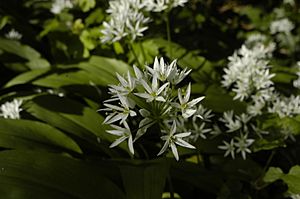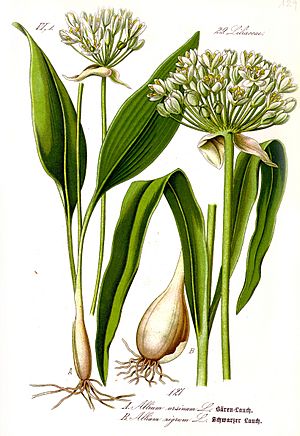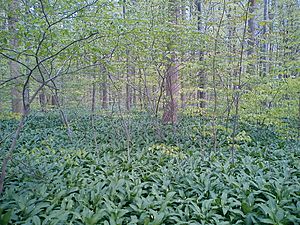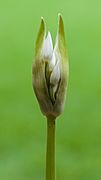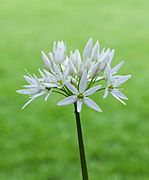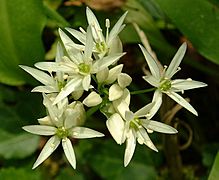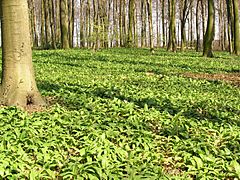Allium ursinum facts for kids
Quick facts for kids Allium ursinum |
|
|---|---|
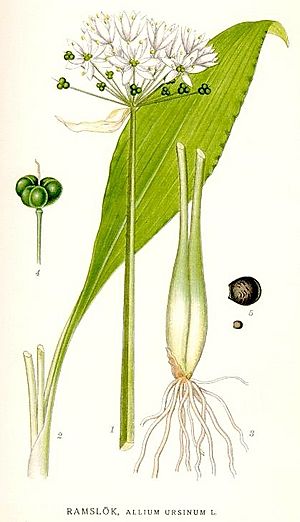 |
|
| Scientific classification | |
| Synonyms | |
|
Species synonymy
Aglitheis ursina (L.) Raf.
Allium latifolium Gilib. Allium longipetiolatum St.-Lag. Allium nemorale Salisb. Allium petiolatum Lam. Allium ucrainicum (Oksner & Kleopow) Bordz. Allium ursinoides G.Don ex Sweet Allium ursinum subsp. ucrainicum Oksner & Kleopow Allium ursinum var. ucrainicum (Oksner & Kleopow) Soó Allium ursinum subsp. ucrainicum Kleop. & Oxner Allium vincetoxicum Pall. ex Ledeb. Cepa ursina (L.) Bernh. Geboscon ursinum (L.) Raf. Hylogeton ursinum (L.) Salisb. Moly latifolium (Gilib.) Gray Ophioscorodon ursinum (L.) Wallr. |
Allium ursinum, also known as wild garlic or ramsons, is a plant with a bulb that grows back every year. It is a flowering plant in the amaryllis family. This plant is native to Europe and Asia. It likes to grow in moist woodlands. Wild garlic is a relative of onion and garlic, and they all belong to the same plant group called Allium. There are two main types of wild garlic: A. ursinum subsp. ursinum and A. ursinum subsp. ucrainicum.
Contents
What's in a Name?
The scientific name ursinum comes from the Latin word for 'bear'. People used to believe that brown bears enjoyed eating the bulbs of this plant after waking up from their long winter sleep. Some old stories even say bears would eat them to regain their strength.
Another idea is that "ursinum" might refer to Ursa Major, a constellation of stars. This is because A. ursinum was possibly one of the northernmost Allium plants known to the ancient Greeks. Many common names for this plant in different languages also mention bears.
People also call it "cows's leek" because cows love to eat it. In some places, like Devon, dairy farmers have had their milk rejected. This happened because the cows ate wild garlic, which gave the milk a garlic flavor.
The name "ramsons" comes from an old Saxon word, hramsa, which means "garlic." People in England have used wild garlic in their cooking for over 1,500 years, even since the time of the Celtic Britons.
Ancient healers, including the Celts, Teutonic tribes, and Romans, knew about this wild plant. They called it herba salutaris, meaning 'healing herb'.
How to Spot Wild Garlic
Wild garlic is a plant that grows from a bulb and comes back each year. It mainly spreads by seeds. It has bright green, oval-shaped leaves that can be up to 25 centimeters (about 10 inches) long and 7 centimeters (about 3 inches) wide. The leaves have a stem up to 20 centimeters (about 8 inches) long.
The plant produces a cluster of six to 20 white flowers. These flowers look like stars with six white petals and are about 16–20 millimeters (about 0.6–0.8 inches) wide. Unlike some other garlic plants, wild garlic does not produce small bulbs in its flower head.
In the British Isles, wild garlic flowers from April to June. It often blooms before the leaves appear on deciduous trees in the spring. The flower stem is shaped like a triangle. Its broad, spear-shaped leaves look a bit like the leaves of the poisonous lily of the valley.
Where Does it Grow?
Wild garlic grows in the mild parts of Europe. You can find it from Britain in the west all the way to the Caucasus mountains in the east. It is very common in most of the British Isles, except for the far north of Scotland, Orkney, Shetland, and the Channel Islands. The ursinum type is found in western and central Europe. The ucrainicum type grows in eastern and southeastern Europe.
Traditional Uses
People have long believed that Allium ursinum has many good qualities for health. It is sometimes used in traditional remedies for problems with the heart, breathing, and digestion. It has also been used to help clean wounds.
Wild garlic contains higher amounts of some minerals compared to regular garlic. It is sometimes called the "magnesium king" of plants. This is because its leaves have a lot of magnesium. Magnesium is known to help with stress and protect the heart and blood system.
Where Wild Garlic Likes to Live
Wild garlic grows well in deciduous woodlands. It prefers moist soil that is slightly acidic. In the British Isles, you often find wild garlic growing with bluebells (Hyacinthoides non-scripta). This is especially true in very old forests. Because of this, wild garlic is seen as a sign that a woodland is ancient.
Cooking with Wild Garlic
All parts of the wild garlic plant are edible and can be used in cooking. Even the flowers can be used to decorate salads.
The leaves are the most popular part to use. You can add them raw to salads. They have a mild garlic flavor, similar to garlic chives. When you pick the leaves, they bruise easily and smell even stronger. If you cook the leaves, their flavor becomes softer and sweeter.
People often chop the leaves and use them instead of garlic or other herbs in many recipes. The bulb can be used just like regular garlic cloves.
Some popular dishes made with wild garlic include pesto, soups, pasta, and even cheese. A type of Cornish Yarg cheese has a rind covered in wild garlic leaves. In Russia, the stems are preserved with salt and eaten in salads. The leaves can also be pickled, similar to how mountain garlic is prepared in Korea.
People have been using wild garlic for a very long time. The oldest proof of humans using it comes from a very old settlement in Denmark. There, scientists found an impression of a wild garlic leaf. In a Swiss settlement from the Stone Age, a lot of wild garlic pollen was found. Some think this means it was used to feed animals.
Be Careful: Look-Alikes!
It's very important to know that some poisonous plants look similar to wild garlic. These include lily of the valley, Colchicum autumnale, Arum maculatum, and Veratrum viride or Veratrum album. In Europe, where many people gather wild garlic from nature, some get sick because they accidentally pick a poisonous plant instead.
One way to check is to crush the leaves between your fingers. Wild garlic will have a strong garlic smell. However, be careful! If the garlic smell stays on your hands, you might accidentally think a poisonous plant smells like garlic too.
When wild garlic and Arum maculatum first sprout, they look alike. But when Arum maculatum leaves open, they have uneven edges and many deep veins. Wild garlic leaves are curved and have only one main vein. Lily of the valley leaves grow in pairs, are dull green, and come from a single reddish-purple stem. Wild garlic leaves grow separately, are shiny at first, and are bright green.
Wild Garlic in Nature
As its name suggests, A. ursinum is an important food source for brown bears. It is also a favorite food for wild boar.
Wild garlic is the main plant where a special type of hoverfly, the ramsons hoverfly, lays its eggs.
The flowers of wild garlic are pollinated by bees.
Gallery
See also
 In Spanish: Ajo de oso para niños
In Spanish: Ajo de oso para niños


